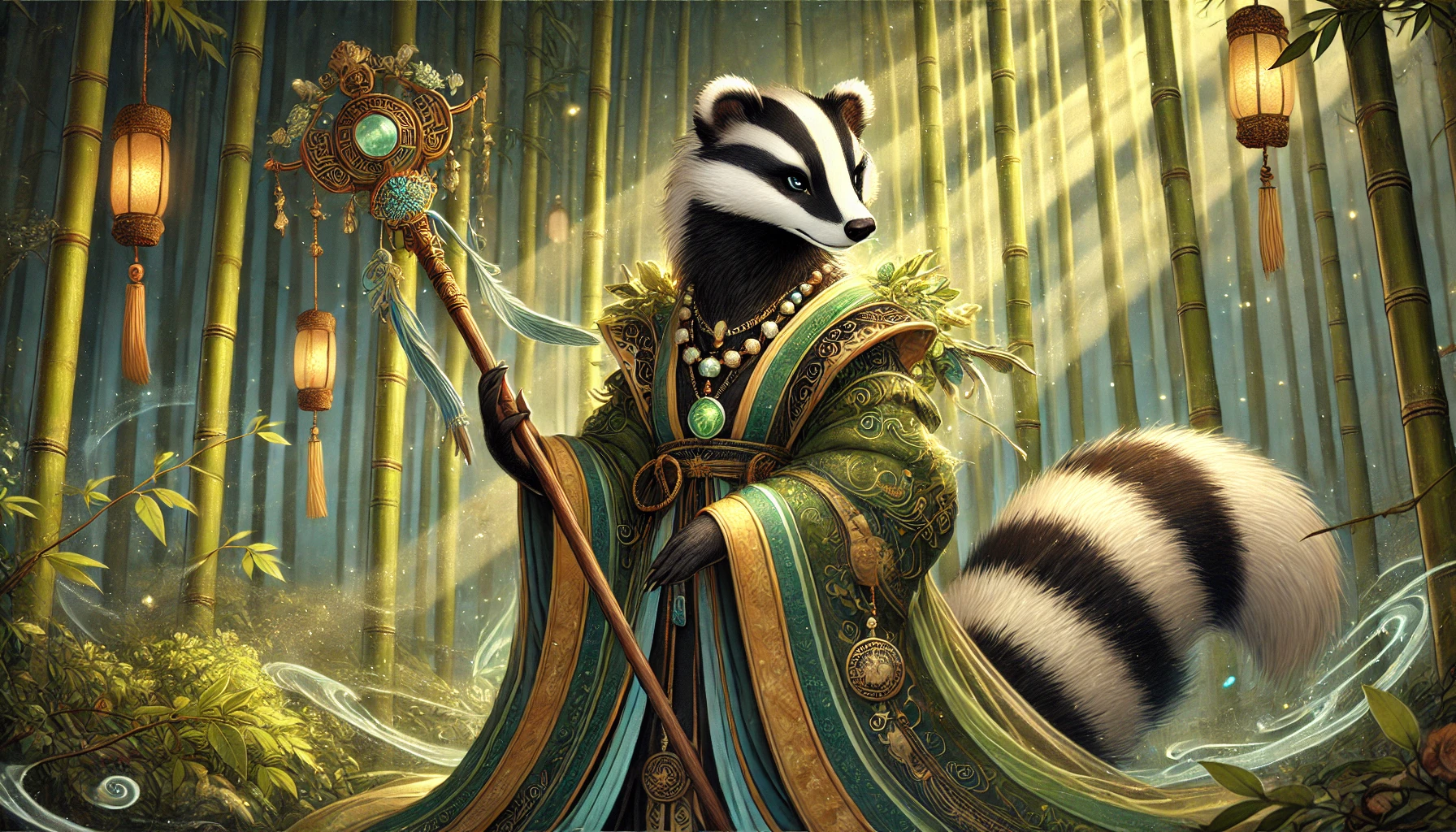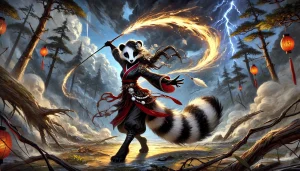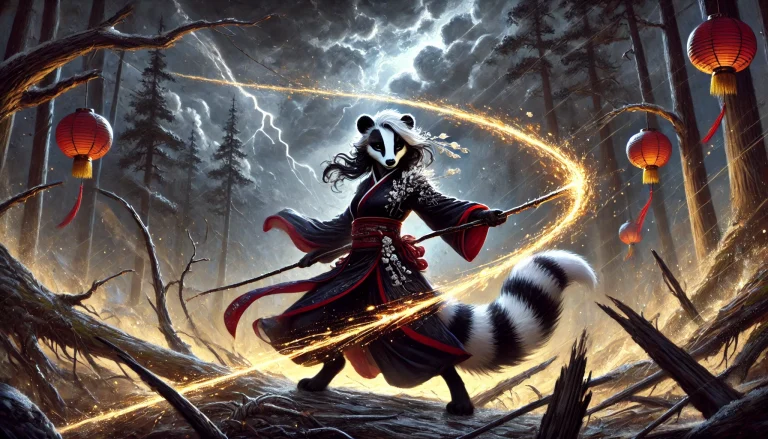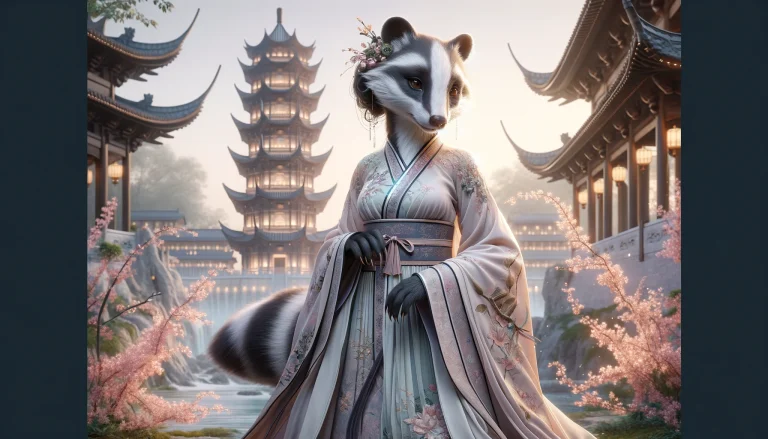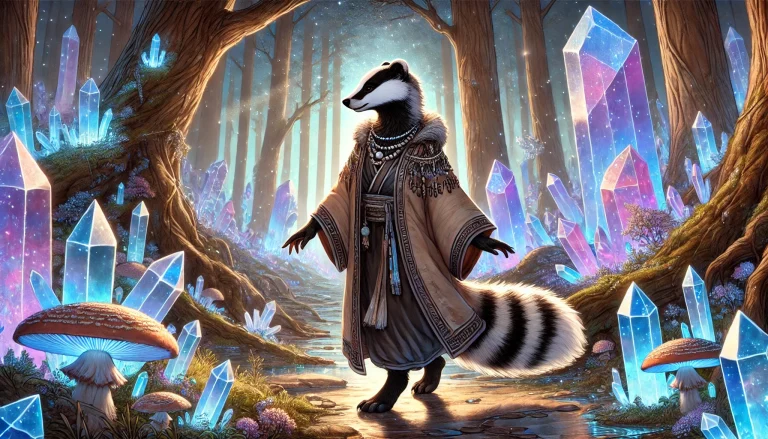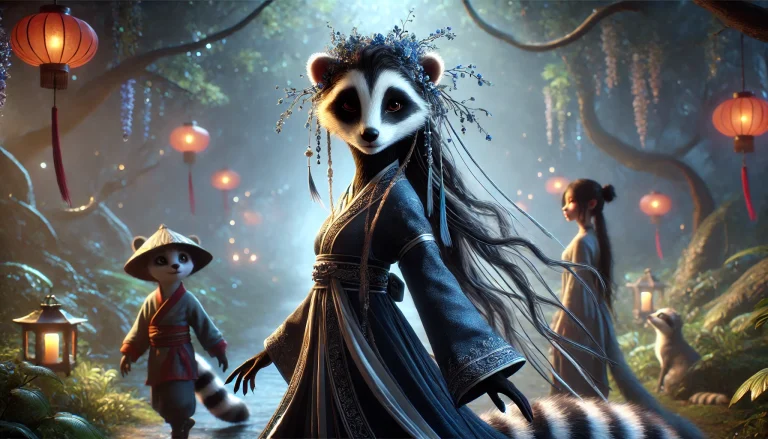Chinese shamanism emerges from the depths of history as one of the oldest and most complex spiritual traditions in the world. Born from the intimate connection between human beings and the primordial forces of nature, it carries an ancient wisdom that spans millennia, weaving a sacred web between the visible and the invisible, the mundane and the divine.
More than a religion or belief system, Chinese shamanism is a spiritual practice that transcends simple definitions. In essence, it is an art of communication with different levels of reality, where the shaman acts as a living bridge between the material world and the spiritual realms - inhabited by spirits, ancestors and cosmic forces. Through rituals, sacred chants and meditative practices, this tradition seeks to restore the balance between the human being and the surrounding universe.
On this journey of discovery, we will explore the historical roots of this ancient tradition, delving into its sacred rituals and age-old symbols. We'll see how this ancient wisdom continues to resonate in modern times, offering paths to healing, transformation and reconnection with our true essence.
Index
Origins and History of Chinese Shamanism
The origins of Chinese shamanism go back to the dawn of civilization, taking root in the spiritual practices of the tribes that inhabited the various regions of what we now know as China. In these primitive communities, the shamans, known as wu (巫)They were seen as sacred mediators between the material and spiritual worlds.
Shamanism in the Neolithic Period
During the Neolithic period (around 5000-2000 BC), archaeological evidence indicates the practice of shamanism at sites such as Banpo and Hongshan. Ritual objects, ceremonial masks and cave paintings suggest sophisticated practices of communication with nature spirits and ancestors, reflecting a deep connection between human beings and the cosmos.
Evolution under the Imperial Dynasties
With the advent of the imperial dynasties, shamanism evolved in a unique way. At court, the wu-xi (巫觋) - official shamans - performed elaborate rituals to harmonize Heaven and Earth. During the Shang Dynasty (1600-1046 BC)For example, shamans used oracular bones to predict the future and advise rulers, which gave us the first records of Chinese writing.
The influence of taoism introduced new concepts to Chinese shamanism, such as the qi (气) - vital energy - and balance yin-yang (阴阳). Mystical Taoism, in particular, shared many similarities with shamanic practices, such as ecstatic techniques and spiritual journeys, creating a unique synthesis between the two traditions.
The ConfucianismAlthough he was critical of popular shamanic practices, he preserved and refined ancestral state rituals. This generated an interesting duality: while official shamanism became more formal and hierarchical, popular practices continued to preserve spontaneous and ancestral elements, keeping the essence of this tradition alive.
Regional Diversity in Chinese Shamanism
The richness of Chinese shamanism also lies in its regional diversity, with practices that reflect the cultural specificities of each region:
- In northern China:
- In ManchuriaThe Tungus shamans developed specific techniques to communicate with animal spirits, especially the tiger and the deer.
- In Inner MongoliaAs a result, shamanic practices merged with Tibetan Buddhism, creating a unique tradition of healing and prophecy.
- In the Amur RiverThe ancient techniques of shamanic drumming and ritual dances are still alive today.
- In southern China:
- In Yunnanthe shamans of the Naxi and Yi ethnic groups have kept the tradition of sacred pictograms alive dongbaused in healing rituals and communication with the spirit world.
- In the mountains of GuizhouThe Miao communities have created healing rituals that combine medicinal herbs, music and shamanic practices with traditional knowledge of natural medicine.
- On the border with Tibet, shamanism merged with practices bönIt creates a synthesis of meditative techniques and rituals that reflect the rich cultural interaction of the region.
The Influence of Buddhism and the Resilience of Shamanism
The arrival of Buddhism in China during the Han Dynasty (206 BC - 220 AD)brought new dimensions to shamanic practices. Concepts such as karma e reincarnation have been incorporated into the shamanic spiritual vision, while Buddhist meditation techniques have enriched traditional methods of achieving altered states of consciousness.
Even in periods of religious repression, such as during the Qing Dynasty (1644-1912)Shamanism has survived by adapting and hiding in different forms. Its teachings have been preserved in traditional medicine practices, martial arts and folk rituals, demonstrating the impressive resilience of this ancient tradition.
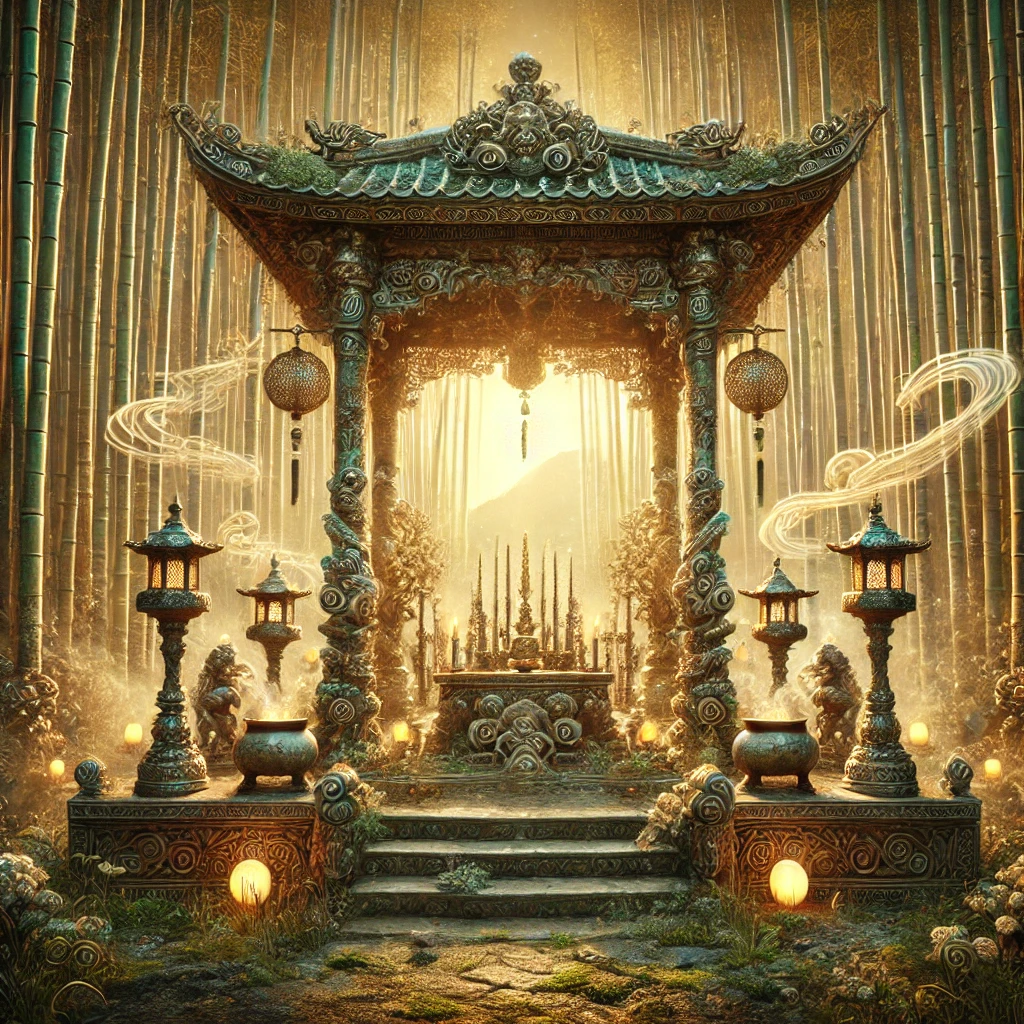
Cosmology of Chinese Shamanism
In Chinese shamanism, the universe is understood as a living web of relationships between different levels of reality. This ancient vision, which predates the great Chinese philosophies, understands that all existence is permeated and sustained by the Qi (气)The primordial life force that flows through all dimensions of being.
An Interconnected Worldview
Chinese shamanism is based on the deep connection between the Heaven, Earth and Manwhere Qi is the central element in this interaction. It acts as the energy that unites all aspects of existence, circulating not only in the human body, but also in the spiritual and natural realms, guaranteeing cosmic balance.
The Three Realms: Dimensions of the Shamanic Journey
The shaman's journey takes place between Three Kingdomswhich represent different levels of Qi manifestation:
- Upper World (Shangqian):
A realm of light and celestial order, inhabited by supreme deities and high spirits. This realm of energy yang Pure is the source of divine inspiration and the cosmic laws that govern existence. Shamans visit the Upper World in search of spiritual guidance, healing and transcendental knowledge. - Middle World (Zhongyuan):
The plane of physical manifestation, where Qi condenses into material forms. Here, humans and nature spirits coexist, interacting in a constant dance. Every mountain, river, forest or stone is inhabited by shen (natural spirits), who guarantee the balance of the elements. The shaman develops a deep connection with these spirits, learning the language of nature in order to act as a healer and harmonizer. - Underworld (Xiafang):
Unlike the Western conception of "hell", the Underworld is a sacred realm of regeneration and ancestral wisdom. Here reside the ancestors and the telluric forces of transformation. The shaman finds the deepest roots of existence in this realm, connecting with his ancestral lineage and the secrets of spiritual renewal.
Ancestry and Nature Spirits
Ancestry plays a central role in Chinese shamanism. Ancestors are not seen as distant entities, but as living presences who continue to participate in the lives of their descendants. Through elaborate rituals, offerings and seasonal celebrations, a continuous dialog is maintained with these ancestors. During the Qingming FestivalFor example, families visit the graves of their ancestors to renew the bonds that transcend the barrier between life and death.
In addition to the ancestors, the shen - nature spirits - play an essential role. They are guardians of the natural elements, and the shaman acts as a mediator between human beings and these spirits, ensuring harmony and balance between the two.
The Shaman's Journey: Between the Worlds
The shaman develops the ability to move between the Three Realms through specific techniques to alter their consciousness. These practices include:
- The sound of the ritual drum:
The rhythm of the drum replicates the heartbeat of the Earth, serving as a vehicle for journeys between worlds. - Sacred dances:
They embody the movements of the elements and spirits, allowing the shaman to tune in to their energies. - Shamanic chants:
Transmitted from generation to generation, they carry vibrational frequencies that open portals between dimensions.
The complex web of relationships between the Three Realms is sustained by a constant flow of Qi. The shaman learns to perceive and manipulate these energy flows, using them to restore balance where it has been disturbed. Whether healing illnesses, harmonizing relationships or mediating between humans and spirits, the shaman acts as a guardian of the sacred balance.
Chinese Shamanic Practices and Rituals
Wu plays a central role in Chinese shamanic tradition, serving as the guardian of harmony between the visible and invisible worlds. Its tools, rituals and practices reflect a deep connection with the Qi and with the cosmic forces that sustain the universe. Through his work as a healer, mediator and spiritual leader, Wu preserves a tradition that continues to inspire and transform lives, connecting them with the sacred essence of existence.
The Wu (巫): The Shaman in the Chinese Tradition
In Chinese tradition, the Wu (巫)The shaman, or shaman, occupies a unique position as a mediator between the visible and invisible worlds. Their journey often begins with a "shamanic illness" - a deep spiritual crisis that symbolizes the initial call to the shamanic path. This initiation process is marked by years of apprenticeship under the guidance of experienced masters, during which the initiate develops their psychic abilities, discovers the ancient secrets of the tradition and prepares to act as a bridge between the spiritual and material realms.
Wu's Sacred Tools
The Wu use sacred tools that amplify their power and facilitate their connection with the spiritual world. Each object has a special meaning and a unique function in the rituals:
- Ritual drum (gu):
The drum is the main vehicle for the journey between worlds. Its rhythm, which imitates the heartbeat of the Earth, induces altered states of consciousness necessary for shamanic work. - Bronze mirrors (jian):
Used to reflect and direct spiritual energies. They also serve as protection, warding off negative influences during rituals. - Bells and gongs (zhong):
They disperse negative energies and purify the ritualistic environment, creating a space conducive to spiritual practice. - I Ching:
The classic of Chinese divination is consulted for spiritual guidance and decision-making, connecting Wu to ancestral wisdom. - Principles of Feng Shui:
Used to harmonize sacred spaces, ensuring that the flow of Qi (vital energy) is balanced and favorable to rituals.
Healing rituals
Healing is one of the most significant practices in Chinese shamanism. Wu identifies imbalances in the flow of Qi through divinatory techniques, such as readings of grains of rice, coins or oracular bones. Healing rituals can include:
- Extraction of harmful energies:
The shaman removes negative influences or disturbing spirits that affect the individual's health or well-being. - Restoration of the soul (hun):
It works to recover parts of the soul that may have been lost due to trauma or illness. - Harmonization of internal elements:
It seeks to balance the forces yin e yang in body and mind, promoting health and harmony. - Negotiating with spirits:
Wu acts as a mediator, establishing agreements or offerings to pacify spirits that are causing imbalances or illnesses.
Music, Dance and Seasonal Rituals
Music and dance play an essential role in Chinese shamanic rituals. Through specific movements that imitate power animals and natural elements, Wu connects with cosmic forces. Other fundamental elements include:
- Sacred songs:
Passed down orally through generations, these chants invoke spirits and healing energies. They also help to open portals between spiritual dimensions. - The rhythm of the drum:
The repetitive sound of the drum, combined with movements and chants, induces altered states of consciousness necessary for shamanic journeys.
Seasonal rituals
Seasonal rituals integrate the community into collective celebrations, aligning it with the cycle of nature and spiritual connection. Among the most significant are:
- Qingming Festival:
During this celebration, the Wu lead ceremonies in honor of the ancestors, renewing the bonds between the living and the dead. - Lunar New Year:
Rituals of purification and renewal are performed to ward off the negative energies of the previous year and attract prosperity for the new cycle.
Each ritual is a multi-sensory experience, where sound, movement and sacred intention combine to create a living bridge between the human and spiritual worlds.
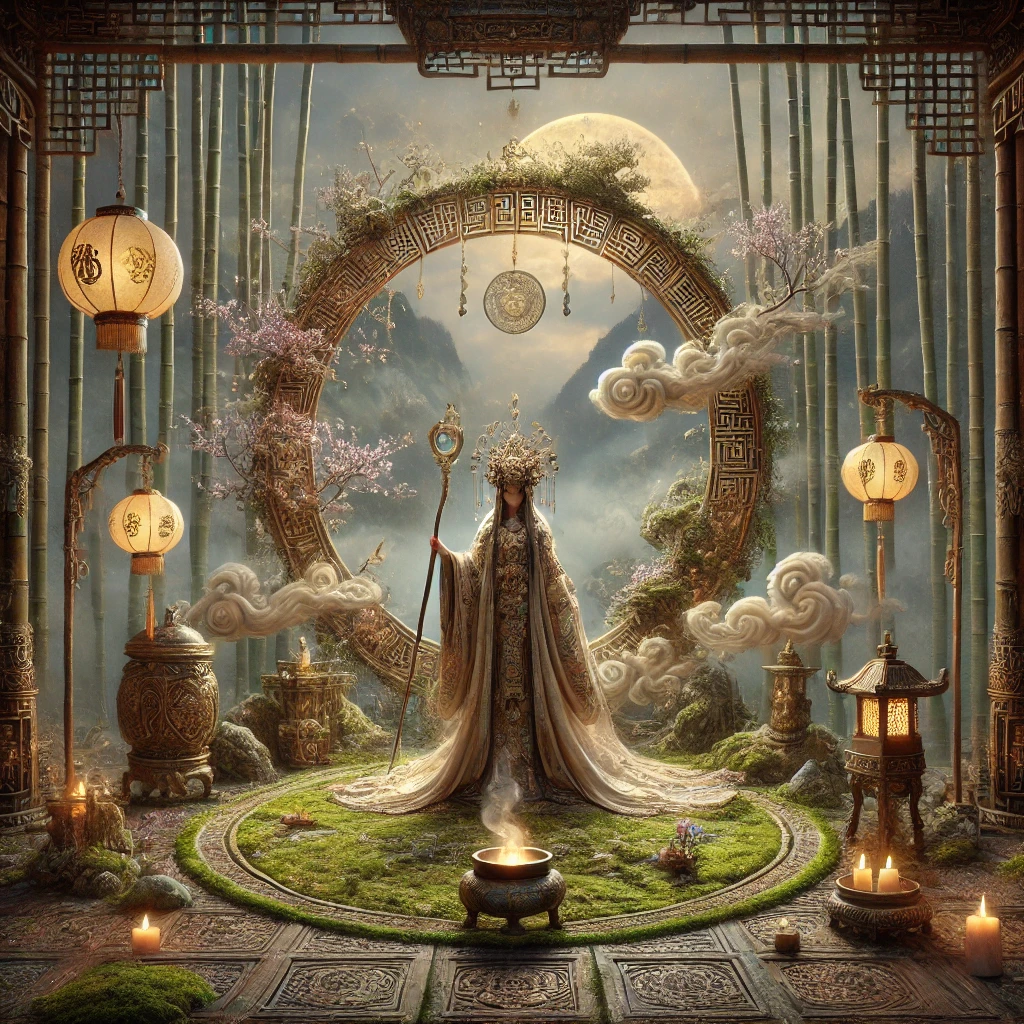
Connection with Nature and the Cosmos
In the ancient wisdom of Chinese shamanism, nature is not just scenery, but a living fabric of consciousness and mystery. The sacred mountains stand like silent elders, their rocky faces marked by time immemorial, holding in their valleys the whispers of ancestral spirits.
The rivers wind through the land like crystal-clear dragons, carrying in their currents the memories of ages past. Each drop of water tells stories of transformation and rebirth, while the ancient trees, with their branches stretching out like bridges between heaven and earth, plunge their roots into the secrets of the underground world.
In the eternal dance between light and shadow, the lunar calendar reveals the sacred moments of the year. When the full moon bathes the world in its silvery light, the veils between the worlds become thinner. The shamans, to the rhythm of the ancestral drums, dance as living vessels of the celestial forces, connecting the human to the divine.
On the winter solstice, when darkness reaches its peak, shamans light sacred fires to honor the return of light. This is a time of communion with the ancestors, where ancient stories are whispered around the dancing flames, and spirits walk close to the living.
The constellations shine in the night sky like celestial lanterns, guiding spiritual travelers through invisible realms. O Great Bear of the North (北斗七星) revolves eternally around the North Star, marking the center of the sacred cosmos, while the Milky Way flows like a river of stars, connecting the terrestrial and celestial realms.
The Dance of the Lunar Phases
Each phase of the moon carries unique mysteries and specific blessings that guide the spiritual journey:
- Crescent moon:
The seeds of dreams are planted in the gardens of the spirit, preparing the ground for new intentions and projects. - Full moon:
Its silver light amplifies the powers of healing, clairvoyance and spiritual connection, uniting the visible and invisible worlds. - Waning moon:
The energies return to the earth, cleansing impurities and blockages, making room for renewal. - New moon:
In the darkness of sacred silence, shamans plunge into the depths of the unconscious, listening to the eternal secrets that whisper from the roots of the cosmos.
Guardians of the Cosmic Rhythms
This cosmic dance between heaven and earth, light and shadow, the manifest and the occult, forms a sacred tapestry where each thread is interwoven with divine purpose. Shamans, in their ancestral wisdom, learn to read the patterns of this tapestry, becoming guardians of the eternal rhythms of nature and the cosmos.
Chinese Shamanism and Other Spiritual Traditions
In the heart of ancient China, shamanism wove an eternal dance with other spiritual traditions, creating a sacred tapestry of wisdom and mystery. Like a river that meets other streams, Chinese shamanism flowed naturally into Taoism, dialogued with Buddhism and interacted with Confucianism, integrating elements of each system while preserving its ancestral essence.
The Dance between Shamanism and Taoism
In the shamanic-taoist vision, Yin and Yang are not just philosophical concepts, but living forces that permeate all levels of reality. Like the Taoist sage, the shaman learns to dance between these polarities, recognizing that in the deepest darkness (yin) is the seed of the brightest light (yang).
This sacred dance manifests itself in shamanic healing rituals, where the balance between these primordial forces is restored through chants, ritualistic movements and ancestral invocations. The influence of the Tao, as the ineffable path that permeates all existence, is present in shamanic practice, connecting the human with the cosmic forces that sustain the universe.
The Influence of Buddhism
With the arrival of Buddhism in China, new dimensions were added to shamanic practice. Buddhist meditation practices were integrated into shamanic rituals, while Buddhist monasteries absorbed shamanic elements into their ceremonies.
This spiritual fusion has created a unique tradition, where the quest for Buddhist enlightenment intertwines with the ancient wisdom of natural spirits. This interaction has given rise to practices that blend meditative serenity with the dynamic energy of shamanic rituals.
The Dialogue with Confucianism
Although Confucianism, with its focus on social order and ethics, seems distant from shamanic practices, it has preserved important aspects of this tradition. Confucian state rituals maintained shamanic elements in ceremonies aimed at the imperial ancestors and the harmonization of Heaven and Earth.
This integration demonstrates how Confucian reverence for ancestors and cosmic harmony aligns with the core principles of shamanism, albeit expressed in a more formal and hierarchical way.
Comparisons with Other Shamanic Traditions
Chinese shamanism stands out among other shamanic traditions for its sophistication and integration with philosophical and religious systems. Unlike more direct practices such as Siberian shamanismwhich emphasizes a visceral connection with animal spirits and raw natural forces, Chinese shamanism has developed a complex system of cosmological correspondencesIt is enriched by Taoist, Buddhist and Confucian practices.
- Korean Shamanism (Muism):
It shares with Chinese shamanism the emphasis on ancestral rituals and sacred dances, but has unique characteristics, such as the predominant role of the Mudang (women shamans), who perform healing and spiritual mediation functions. - Indigenous Shamanic Traditions of the Americas:
Although also based on communication with spirits and the use of sacred plants, these traditions developed more direct and visceral paths, centered on the connection with the earth. In contrast, Chinese shamanism was deeply integrated into philosophical systems, creating more refined and systematized spiritual practices.
The Essence of Chinese Shamanism
The most notable characteristic of Chinese shamanism is its ability to absorb and be absorbed by other traditions, without losing its primordial essence. Like water, which takes the shape of the container that holds it, Chinese shamanism preserves its fluid and vital nature, adapting to cultural and spiritual changes over the centuries.
This aspect of continuous transformation ensures that Chinese shamanism remains alive and relevantA testimony to a timeless wisdom that transcends forms, names and cultural boundaries.
Chinese Shamanism in the Modern World
In the contemporary world, Chinese shamanism pulses like an ancient flame that refuses to go out. In the remote mountain villages of Yunnan and in the vastness of Inner MongoliaThe elders preserve the sacred rituals passed down through generations. Their wrinkled hands play ancestral drums while their feet dance to the rhythm of melodies that echo through the ages, keeping alive a deep-rooted tradition.
Survival in Modern Cities
Although the urban world seems far removed from shamanic practices, Chinese shamanism has found ways to survive and adapt to modern cities. In small temples hidden among skyscrapers, contemporary practitioners reinterpret ancient rituals to meet current needs.
In addition, shamanic knowledge has a profound influence on Traditional Chinese Medicine (TCM), which integrates concepts of energy balance and spiritual connection. Ancestral practices are preserved and applied in modern approaches such as:
- Acupuncture:
Based on the energy meridians that ancient shamans mapped out on their spiritual journeys. - Phytotherapy:
A sacred legacy of the use of medicinal plants, where each herb is seen not just as physical matter, but as a living spirit with unique properties. - Qigong:
It incorporates movements inspired by shamanic dances, promoting harmony in the flow of Qi (vital energy).
The interest of the West
In the West, more and more people are seeking spiritual reconnection in a world marked by materialism. This search has brought attention to Chinese shamanic practices, attracting both scholars how much spiritual seekers.
Workshops, retreats and study centers have flourished, offering a bridge between ancient Chinese wisdom and the needs of modern consciousness. These gatherings help translate shamanic practices for a global audience, preserving their essence while making them accessible.
Challenges of Modernity
Despite this resurgence in global interest, Chinese shamanism faces challenges in adapting to the contemporary world:
- Preservation of the Sacred Essence:
How can we maintain the sacredness of these practices in a world dominated by technology and rational thinking? - Translation for Modernity:
How can ancestral rituals be reinterpreted so that they resonate with modern minds without losing their spiritual and transformative power?
The answer may lie in the very essence of Chinese shamanism: its ability to adaptIt's like water that flows to mold itself to the container without losing its nature. In integrative medicine clinics, contemporary shamans work side by side with Western doctors, while research centers are beginning to explore the measurable effects of shamanic practices on physical and mental health.
Continuous Evolution
Chinese shamanism continues to evolve, like an ancient tree that grows new branches without losing its deep roots.
In China's megacities, the shamanic drum still beats, even if it is muffled by urban noise. In remote villages, it echoes with the force of ages past. In both worlds, it reminds us of our eternal connection with the spirits of earth and heavenand the need to live in harmony with the cosmos.
Challenges and Future of Chinese Shamanism
On the threshold between tradition and modernity, the Chinese shamanism faces profound challenges. In big cities, ancestral temples are giving way to shopping malls, while young people, seduced by the promises of progress, are distancing themselves from traditional practices. The last shaman masters, guardians of ancient wisdom, are aging without successors to inherit their sacred secrets.
The Transformation of the Spiritual Landscape
Unbridled urbanization not only alters the physical landscapebut it also has a profound impact on spiritual fabric of Chinese society. Sacred mountains are pierced by tunnels, ancient rivers are dammed, and forests inhabited by spirits are cut down.
Every century-old tree that falls takes with it untold stories, and every demolished temple silences ancient chants that connected man to the cosmos. These acts not only represent material losses, but also a break with the traditions that have sustained the spirituality of the Chinese people for centuries.
Movements of Resistance and Renewal
Despite this apparent dissolution, movements of resistance and renewal are emerging in various parts of the country. Groups of scholars, practitioners and communities work tirelessly to preserve shamanic knowledge.
- Documentation and Research:
Chinese universities, through their cultural anthropology departments, catalog rituals, practices and legends to prevent them from being forgotten. - Traditional Chinese Medicine:
Shamanic elements, such as the vision of energy balance and the use of sacred plants, continue to be integrated into holistic healing practices.
These efforts reflect an attempt to balance modernity and tradition, ensuring that Chinese shamanism remains alive and relevant.
Answers to Modern Crises
At the heart of Chinese shamanism are teachings that can offer profound responses to contemporary crisesIt stands out in three main areas:
- Ecological Crisis:
The shamanic vision of interconnection between all beings is a powerful antidote to environmental destruction. It teaches us that harmony with nature is essential for collective survival. - Holistic Health:
Shamanism promotes an integrated approach to body, mind and spiritoffering alternatives to the mechanistic medical model so common in the modern world. - Community and Ancestry:
In contrast to extreme individualism, shamanism values community ties and the connection with ancestors, reminding us that we are part of something bigger than ourselves.
Relevance in Today's World
On a planet on the brink of environmental and social collapse, the shamanic vision of respect for natural cycles e balance between opposing forces has never been more relevant. His teachings can offer not only spiritual reflections, but also practical ways to face the challenges of our civilization.
By seeking harmony with nature and celebrating the interdependence of all beings, Chinese shamanism reminds us of the urgency of reviewing our relationship with the natural world.
The Future of Chinese Shamanism
The future of Chinese shamanism will depend on its ability to adapting to the modern world without losing its sacred essence. Like the phoenix rising from the ashes, this ancient tradition has the potential to emerge transformed, offering its wisdom to the wounds of the present.
In the midst of uncertainty and change, the shamanic drum continues to beat, echoing the call for us to remember our eternal connection with Earth and Heaven. This ancient practice, resilient and fluid like water, can flourish again, illuminating paths of healing, balance and renewal for future generations.
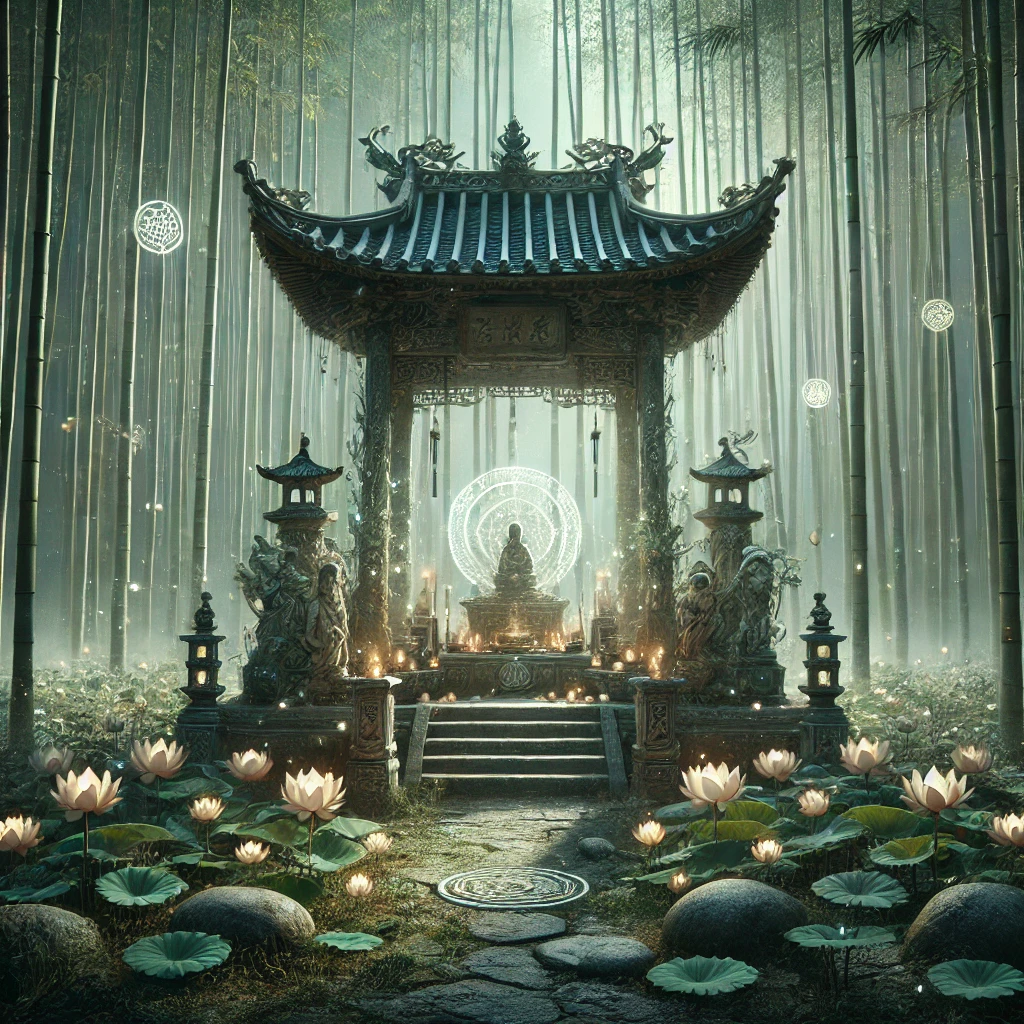
Chinese Shamanic Practices: Connecting the Visible and the Invisible
O Chinese shamanism is a deeply practical tradition, full of techniques and rituals designed to restore the balance between human beings and the cosmos. These practices, handed down over millennia, remain alive in both rural and urban contexts, adapting to the needs of the modern world.
Spiritual Journeys and Altered States of Consciousness
- Ritual drum (gu):
The sound of the drum is used to induce altered states of consciousness, allowing the shaman to travel between the Three Kingdoms (Heaven, Earth and Underworld). - Meditation and visualization:
Meditative techniques and visualization practices help the shaman to access spiritual realms and receive guidance from deities, ancestors or nature spirits.
Healing and Harmonizing Rituals
- Extraction of harmful energies:
The shaman identifies and removes blockages or negative influences in a person's energy field. - Restoration of the soul (hun):
Practices aimed at recovering lost parts of the soul, usually due to trauma or illness. - Qi harmonization:
Techniques to balance the flow of vital energy (Qi) on the body, using movements, chants and sacred invocations.
Divination and Communication with Spirits
- Divination tools:
Oracular bones, coins or grains of rice are used to predict the future and seek spiritual guidance. - Invocation rituals:
Specific ceremonies make it possible to establish a dialog with ancestral spirits, deities or natural entities, strengthening the connection between the visible and the invisible.
Seasonal Rituals and Celebrations
- Qingming Festival:
Ceremonies designed to honor the ancestors, renewing the spiritual ties between the living and the dead. - Solstices and equinoxes:
Rituals that celebrate the natural cycles and the harmony between the Heaven and Earthconnecting the community to the rhythm of the cosmos.
Traditional Chinese Medicine (TCM) Integrated Practices
- Acupuncture:
Based on the mapping of energy meridiansa legacy of shamanic knowledge about the flow of Qi in the body. - Phytotherapy:
The use of medicinal plants, which are recognized not only for their physical properties, but also for their spirits and subtle energies. - Qigong:
Movements and exercises inspired by shamanic danceswhich aim to harmonize the body, mind and vital energy.
Protection and Purification Techniques
- Bronze mirrors (jian):
Used to reflect and ward off negative energies, protecting the shaman during rituals. - Bells and gongs:
Instruments used to disperse unwanted spiritual influences and purifying sacred spacescreating an environment conducive to shamanic practices.
Chinese shamanic practices, with their wealth of techniques and ancient wisdom, continue to be a powerful bridge between the visible and the invisible, connecting the human being to the cosmos and promoting healing, balance and spiritual harmony.
How to Start Practicing Chinese Shamanism: An Introductory Guide
Chinese shamanism is a rich and complex tradition, but beginners can explore its principles and practices in a simple and gradual way. Here are some practical guidelines for those wishing to embark on this spiritual path:
Study and Understand the Fundamentals
- Delve deeper into philosophy: Start by studying essential concepts such as Qi (vital energy), Yin-Yang and the Three Kingdoms (Heaven, Earth and Underworld).
- Get to know the story: Discover the roots of Chinese shamanism and its relationship with the taoism, Buddhism e Confucianism.
- Respect the culture: Understand the importance of honoring ancestors and nature spirits as an essential part of this practice.
Practice Connecting with Nature
- Observe the natural cycles: Tune in to the seasons, the phases of the moon and the solstices.
- Create a natural altar: Choose a place outdoors or at home to set up an altar with elements such as stones, plants, water and incense, symbolizing your connection with Earth and Heaven.
- Meditate outdoors: Sit quietly in a natural place, focusing on your breathing and the feeling of oneness with your surroundings.
Incorporate Simple Energy Healing Practices
- Practice basic Qigong: Learn simple movements to balance the flow of Qi on the body. There are many videos and tutorials online that can help beginners.
- Visualization and breathing: Use visualization techniques to cleanse and harmonize your energy, such as imagining a healing light flowing throughout your body while you breathe deeply.
Explore Divination and Intuition
- Use the I Ching: Start consulting the I Ching (Book of Changes) for spiritual guidance. There are modern, accessible versions that are perfect for those just starting out.
- Develop your intuition: Practice perceiving the signs around you, such as dreams, synchronicities and intuitive sensations, learning to trust your connection with the spiritual world.
Participate in Simple Rituals
- Celebrate the lunar cycles: Perform small rituals during the full moon or new moon, such as lighting candles, burning incense and expressing gratitude for the blessings you have received.
- Honor the ancestors: Set up a small altar with photos or objects that represent your ancestors. Offer food, tea or words of gratitude to strengthen the bond with your lineage.
Respect Limits and Ethics
- Start slowly: Focus on one or two initial practices, developing them with patience and consistency.
- Maintain respect: Remember that Chinese shamanism is a sacred tradition. Approach with humility, reverence and the intention of learning with integrity.
With these steps, you can begin your journey into Chinese shamanism in a simple, conscious and respectful way, allowing this rich tradition to guide you towards spiritual connection and harmony with the universe.
Conclusion
Along this journey through the mysteries of Chinese shamanismWe explore a tradition that persists like an eternal river, flowing from the depths of time to the present day. From sacred mountains to hidden valleys, from ancient imperial courts to modern urban temples, this ancient wisdom continues to weave bridges between worlds and times.
We witness how the Chinese shaman navigates the Three realms of existencedancing between the visible and the invisible. We immerse ourselves in their sacred rituals that maintain the balance between the Heaven and EarthWe listen to the chants that resonate through the veils of reality and we discover the healing practices that restore the harmony of the world. body and soul.
We've seen how ancient techniques - such as the sound of the ritual drum, communication with spirits and the harmonization of Qi - continue to be applied in contexts traditional e modern, demonstrating the resilience and relevance of this wisdom.
We also explored how Chinese shamanism knew how to dialog with other spiritual traditionsTaoism with its search for Tao, Buddhism with its contemplative practices, and Confucianism with its reverence for the ancestors. Like a dragon that changes shape without losing its essence, Chinese shamanism has adapted and evolved, keeping its sacred flame alive.
In a world facing profound crises and transformations, Chinese shamanism has emerged as a source of inspiration. vital wisdom. It reminds us of the interconnectedness of all life, respect for natural cycles and the importance of harmonizing opposites. For modern seekers, practices such as QigongMeditation in natural spaces and honoring the ancestors offer gateways to this rich spiritual tradition.
At the heart of this wisdom is a powerful reminder: we are part of one sacred web of relationships - with the earth that nourishes us, with the ancestors who paved our paths, with the spirits that inhabit the elements and with the infinite mystery that permeates all existence.
As a bridge between the past and the future, between the human and the divine, the Chinese shamanism continues to call us back to the sacred circle of life, inviting us to rediscover our place in the harmony of the cosmos.
I'm passionate about magic and spirituality, always looking for new knowledge about rituals, energies and the mystical universe. Here, I share magical practices and spiritual tips for those who want to connect more deeply with themselves and the world around them, all in a light and accessible way.

